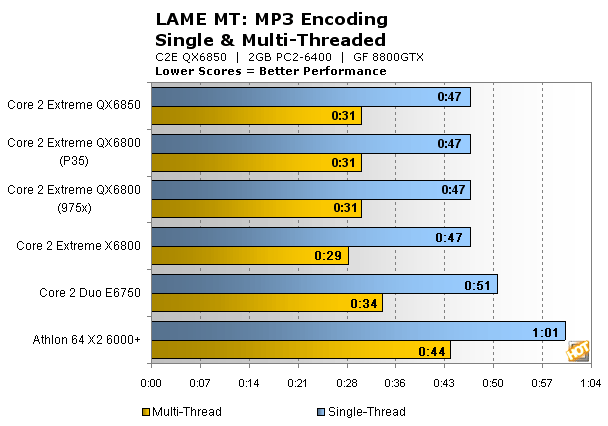Intel Core 2 Extreme QX6850
In our custom LAME MT MP3 encoding test, we convert a large WAV file to the MP3 format, which is a very popular scenario that many end users work with on a day-to-day basis to provide portability and storage of their digital audio content. LAME is an open-source mid to high bit-rate and VBR (variable bit rate) MP3 audio encoder that is used widely around the world in lots of third party applications.
|
|
|
In this test, we created our own 223MB WAV file (a hallucinogenically-induced Grateful Dead jam) and converted it to the MP3 format using the multi-thread capable LAME MT application in single and multi-thread modes. Processing times are recorded below. Once again, shorter times equate to better performance.

Though this version of the LAME encoder is multi-threaded, the application only supports two threads. As a result, all dual and quad-core processors at the same core frequency perform similarly. Again we do see a slight advantage to the dual-core X6800 however, where the system bus is only shared by two cores. Even the QX6850's 1,333MHz FSB speed doesn't make up for this in LAME testing.
|
|
|
Sony's Vegas DV editing software is heavily multi-threaded as it processes and mixes both audio and video streams. This is a new breed of digital video editing software that takes full advantage of current dual and multi-core processor architectures.

With Sony Vegas, the quad-core CPUs in our test reined supreme, offering almost 2X the performance of their dual-core counterparts. In fact, the Core 2 Extreme QX6850 is more than twice as fast as the Core 2 Duo E6750 in Sony Vegas workload processing. What's much more interesting though is that the QX6850 pulled out the win over the 1066MHz FSB / 975X driven QX6800 by a 13% margin of victory. This performance variance is sizeable to be sure and is the sort of gain that would be easily perceptible to the end user within this application. That margin of victory decreases to 15 seconds with the QX6800 running on the P35 chipset, however, which equates to about an 8% lead.







